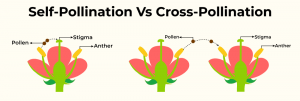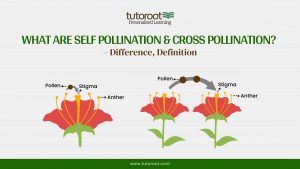What are Self Pollination and Cross Pollination? Difference, Definition
Introduction
Pollination is a crucial process in the reproductive cycle of flowering plants, enabling the transfer of pollen from the male part (anther) to the female part (stigma) of a flower. This process can occur in two primary ways: self-pollination and cross-pollination. Understanding these concepts is essential for students and anyone interested in plant biology. This article explores the definitions, differences, advantages, and disadvantages of self-pollination and cross-pollination, along with examples and diagrams for better comprehension.
Understanding Basics of Self and Cross-Pollination
Pollination is the mechanism through which plants reproduce. It involves the movement of pollen grains from the male anther to the female stigma. This process ensures the fertilization of the ovule, leading to seed formation and the propagation of plant species.
What is Self-Pollination?
Self-pollination occurs when pollen from the anther of a flower lands on the stigma of the same flower or another flower on the same plant. This type of pollination does not require external agents like wind, water, or animals.
This process does not require external agents like wind, water, or animals.
Few Self-Pollination Examples
The examples of self-pollination are given below,
- Pea Plants (Pisum sativum): Known for their self-pollinating ability, pea plants have flowers that close tightly, ensuring that pollen falls directly onto the stigma.
- Tomatoes (Solanum lycopersicum): These plants can self-pollinate within the same flower, thanks to their structure that facilitates direct pollen transfer.
- Wheat (Triticum aestivum): Another example of a self-pollinating plant, wheat often fertilizes itself before the flower even opens.
Advantages and Disadvantages of Self-Pollination
The major advantages and disadvantages of self-pollination are,
Advantages:
- Genetic Consistency: Produces offspring genetically identical to the parent, ensuring trait stability.
- No Dependence on Pollinators: Eliminates the need for pollinators, which can be scarce in some environments.
- Efficient Reproduction: Allows rapid and efficient reproduction, beneficial in stable environments.
Disadvantages:
- Lack of Genetic Diversity: Results in less genetic variation, which can make plants more susceptible to diseases and environmental changes.
- Inbreeding Depression: Continuous self-pollination can lead to inbreeding depression, reducing plant vigour and fertility.
What is Cross-Pollination?
Cross-pollination occurs when pollen from the anther of one flower is transferred to the stigma of another flower on a different plant of the same species. This process often involves external agents like insects, wind, or water.
This process requires external agents such as wind, water, insects, birds, or other animals.
Cross-Pollination Example for Better Understanding
Here are a few best examples of cross-pollination,
- Apple Trees (Malus domestica): Apple trees rely heavily on insects, especially bees, for cross-pollination. The bees transfer pollen from one apple flower to another, facilitating fertilization.
- Pumpkins (Cucurbita pepo): These plants depend on bees to move pollen between male and female flowers, ensuring successful fruit production.
- Oak Trees (Quercus spp.): Wind plays a crucial role in the cross-pollination of oak trees, carrying pollen from one tree to another over long distances.
Types of Cross-Pollination
4 major types of cross-pollination have existed. Here is the complete information for types of cross-pollination.
1. Entomophily (Insect Pollination)
Entomophily involves the transfer of pollen by insects, such as bees, butterflies, and beetles. These insects are attracted to flowers by their colour, scent, and nectar. When insects visit flowers to collect nectar, they inadvertently pick up pollen and transfer it to other flowers.
Example: Bees and Sunflowers (Helianthus annuus) – Bees visit sunflowers for nectar and, in the process, carry pollen from one flower to another, aiding in cross-pollination.
2. Anemophily (Wind Pollination)
Anemophily occurs when pollen is carried by the wind from one flower to another. This type of pollination is common in grasses, trees, and other plants with lightweight, dry pollen that can be easily transported by the breeze.
Example: Corn (Zea mays) – Corn plants produce large amounts of lightweight pollen that are dispersed by the wind to other corn plants, facilitating cross-pollination.
3. Hydrophily (Water Pollination)
Hydrophily is a form of pollination where pollen is transferred through water. This type of pollination is rare and usually occurs in aquatic plants.
Example: Vallisneria spiralis – In this aquatic plant, male flowers release pollen onto the water surface, which is then carried by water currents to female flowers for fertilization.
4. Zoophily (Animal Pollination)
Zoophily involves the transfer of pollen by animals other than insects, such as birds, bats, and other mammals. These animals visit flowers for food, and during their visits, they help in transferring pollen.
Example: Hummingbirds and Hibiscus (Hibiscus rosa-sinensis) – Hummingbirds feed on the nectar of hibiscus flowers and, in the process, transfer pollen from one flower to another.
Advantages and Disadvantages of Cross-Pollination
Here are the advantages and disadvantages of cross-pollination.
Advantages:
- Genetic Diversity: Promotes genetic variation, enhancing plant adaptability and resilience to environmental changes.
- Hybrid Vigor: Cross-pollination can result in hybrid vigour, producing more robust offspring.
Disadvantages:
- Dependence on Pollinators: Relies on external agents, which may not always be available, potentially limiting reproduction.
- Energy Intensive: Requires more energy to produce attractants like nectar, scent, and brightly coloured flowers.
Self-Pollination and Cross-Pollination Diagram
Diagrams are instrumental in understanding the processes of self-pollination and cross-pollination. In self-pollination, the pollen moves within the same flower or plant. In cross-pollination, pollen travels from one plant to another, facilitated by wind, water, or animals. Visual representations can highlight these differences and illustrate the roles of various pollinators.

Difference Between Self Pollination and Cross Pollination
The differences between self-pollination and cross-pollination are tabulated below,
Self-Pollination and Cross-Pollination Difference
| Parameter | Self Pollination | Cross-Pollination |
| Genetic Variation | Low | High |
| Dependency on Pollinators | No | Yes |
| Energy Requirement | Low | High |
| Inbreeding Depression | Possible | Reduced |
| Adaptability | Less adaptable to environmental changes | More adaptable due to genetic diversity |
| Reproductive Assurance | High (no pollinator needed) | Variable (dependent on pollinator availability) |
| Offspring Vigor | Generally less vigorous | Often more vigorous (hybrid vigor) |
| Risk of Disease | Higher due to genetic similarity | Lower due to genetic diversity |
| Flower Characteristics | Generally small, less attractive | Often large, colourful, and fragrant |
| Seed Production | Consistent | Variable, depending on pollinator efficiency |
Final Notes
Understanding self-pollination and cross-pollination is fundamental for studying plant biology and agriculture. Each method has its advantages and disadvantages, influencing plant reproduction, genetic diversity, and adaptability. Recognizing these differences helps in appreciating the complexity and efficiency of nature’s reproductive strategies.
Looking for clear explanations and a deeper understanding of various concepts? Visit the Tutoroot Blog for simplified learning experiences. Enhance your knowledge and get your questions answered with Tutoroot’s Biology online tuitions. Start your journey with Tutoroot’s online home tuitions today by scheduling a FREE DEMO session.
FAQs
Give examples of self-pollination and cross-pollination.
- Self-pollination Example: Pea plants (Pisum sativum).
- Cross-pollination Example: Apple trees (Malus domestica).
What are self and cross-pollination?
- Self-pollination: The transfer of pollen from the anther to the stigma of the same flower or another flower on the same plant.
- Cross-pollination: The transfer of pollen from the anther of one flower to the stigma of a flower on a different plant of the same species.
What are the Self-pollination and cross-pollination differences?
- Self-pollination involves pollen transfer within the same plant, leading to genetic consistency but low diversity.
- Cross-pollination involves pollen transfer between different plants, enhancing genetic diversity and adaptability.

